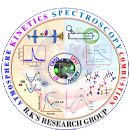Fossil fuels are the major source of energy in the present era. The usage of the fossil fuels takes the major stake as the source for the energy till 2040. The usage of these fuels led to the generation of greenhouse gasses and they are released into the Earth's atmosphere. This is a serious threat in terms of global warming. Therefore, the usage of biofuels as renewable sources seems to be one alternative source for the energy in addition to solar energy and nuclear energy. Although biofuels are acceptable, the emission of greenhouse gasses in the process of combustion should be seriously considered. The reaction mechanisms for the combustion of bigger molecules are much more complicated and lead to various products which may be harmful to atmosphere. Combustion of a fuel can be divided into two categories, complete and incomplete combustion. In complete combustion, fuels burn in oxygen and produce CO2 and H2O as primary products. Incomplete combustion will occur when there is not enough oxygen to allow the fuel to react completely to produce CO2 and H2O. For most of the fuels, such as diesel oil, coal and wood, pyrolysis occurs before combustion. In incomplete combustion, products of pyrolysis remain unburnt and contaminate the smoke with noxious particulate matter and gases. Partially oxidized compounds are also of great concern. For example, partial oxidation of ethanol produces harmful acetaldehyde and toxic CO. Therefore, pyrolysis of biofuels need be fully understood to describe their oxidation. Though the quality of combustion can be improved by changing the design of internal combustion engines, it is difficult to achieve 100% complete combustion. A better understanding of combustion characteristics of these fuels is required before their usage. Unless the deep mechanistic understanding of the decomposition of the proposed or emerging biofuels, it is almost impossible to predict the products.
In our laboratory, we use an inbuilt Single Pulse Shock Tube (SPST) to understand the thermal decomposition of these biofuels, important volatile organic compounds at elevated temperatures relevant to the combustion. SPST techniques is very unique in which a single thermal pulse is generated with a temperature gradient of a million degrees per second that survives for about a maximum of 800 microseconds. This thermal pulse heats the molecules to the desired temperature for such a short time. This means, the molecule under consideration is heated in the temperature zone of 1000 - 2500K and cooled to the room temperature instantaneously. The complete decomposition of the biofuel under consideration is investigated by analyzing the post decomposition products. State of the art diagnostic techniques such as GC-MS, GC-IR, GC with FID, TCD, ECD and NPD, FT-IR with very high resolution are used for this. Complete kinetic simulations are carried out to propose a probable mechanism of decomposition. Computational methods are extensively used to complement our experimental findings.
In addition to the above studies, atomic resonance absorption spectroscopic (ARAS) studies are planned to be carried out to understand the reactions of atoms such as hydrogen with biofuels in the high temperatures. Also, efforts are currently being made to use the laser induced fluorescence (LIF) technique to find the lifetimes of the transient species in the high temperature zone in SPST experiments.
Research Interests
Combustion Chemistry

The inbuilt Single Pulse Shock Tube (SPST) facility


A typical pressure trace recorded by an oscilloscope showing the arrival of primary, reflected shock waves, reaction time and expansion/cooling wave.(Rajakumar et al., J. Phys. Chem. A 2021, 125, 24, 5406-5422)

Sensitivity analysis of the proposed reaction scheme carried out at 1347 K for the formation of methane and ethylene.(Parandaman et al., RSC. Adv. 2015, 5, 86536-86550)

FTIR spectrum of the post-shock mixture of 2-MTHF decomposed at 1345 K. All the peaks are assigned to (A) 2-MTHF,(47) (B) methane,(44) (C) ethane,(44) (D) ethylene,(44) (E) 1,3-butadiene,(49) (F) acetylene,(44,48) (G) acetaldehyde,(44) (H) propylene,(44) (I) carbon monoxide,(48) (J) dihydromethylfuran,(50) and (K) cyclopropyl methyl ketone.(50) Inset plots shown are the expanded regions for CO, methane, and acetylene. [Rajakumar et al., J. Phys. Chem. A 2021, 125, 24, 5406-5422]

Thermal decomposition of 2-butanone - A case study: Comparison of experiment and simulation (Blue: Experiment & Green: Simulation)

